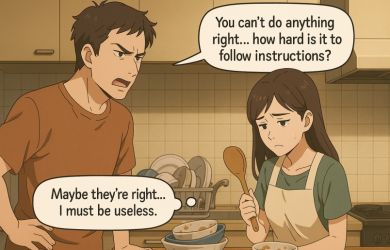7 Key Characteristics of an Abuser in a Relationship

Unlock Daily 30-Sec Tips for a Happier Relationship
👉 Subscribe FREEKey Takeaways
Marriage.com AI Quick Summary
Have you ever felt uneasy around someone you cared for… that subtle tightening in your chest when they check your messages again?
It’s hard to pinpoint what “crosses the line,” especially when control hides behind compliments or fierce jealousy masquerades as a concern! Maybe you’ve brushed off late-night calls, chalked it up to care—only to realize it felt oppressive, unsettling.
Spotting the characteristics of an abuser can start with noticing small inconsistencies: a kind word turned sharp one moment, a promise broken the next, a gentle voice that suddenly commands. These behaviors slip in quietly, eroding trust until it feels too late.
Yet understanding those patterns can bring clarity, relief, and a bit of courage to set boundaries and protect yourself. It might feel scary… but every insight matters!
What does it mean to be in an abusive relationship?
Being in an abusive relationship is waking up to confusion… wondering why a simple disagreement turns into an avalanche of blame. It is feeling “small”; second-guessing choices, shrinking hopes!
How did kindness become a tool for control?
When love feels conditional—punishments disguised as concern—it wears away at confidence. Emotional bruises might not show, but they sting: harsh words, silent treatments, or the weight of unpredictable mood swings.
Studies show that a common pattern of domestic abuse, especially between intimate partners, involves the perpetrator alternating between episodes of violence and abuse and periods of apparent remorse, often accompanied by seemingly sincere promises to change.
It is the clash between heart and mind, hoping for warmth but encountering fear instead. Recognizing this dynamic, painful as it is, can spark the first step toward understanding what one truly deserves.
7 key characteristics of an abuser in a relationship
Some behaviors in a relationship do not start off loud or obvious—they unfold slowly, masked as love, concern, or passion. But over time, patterns emerge… and those patterns matter.
The characteristics of an abuser are not always aggressive at first glance; often, they hide behind charm, silence, or guilt. Here are 7 of the most telling signs to look out for.
1. Controlling behavior
An abuser may want to manage how someone dresses, who they see, or how they spend their time. It can seem subtle at first—”I just care about you”—but it quickly becomes suffocating. This need for control is not about love; it is about power.
Even choices that should feel personal can start to feel like permissions. One of the most common characteristics of an abuser is needing control over another person’s independence.
- Early warning sign!
They may frame control as “just being protective,” but soon, your choices feel like theirs to approve. If you find yourself asking permission for basic things, control might already be at play.
2. Extreme jealousy
At first, jealousy can seem flattering… like someone really cares. But when it becomes intense, constant, or irrational, it can create distance from friends, family, or even coworkers. This type of jealousy often leads to accusations or monitoring behaviors.
Research indicates that jealousy in romantic relationships can lead to harmful outcomes, including breakups and violence. It typically involves a triadic dynamic—the individual, their partner, and a perceived rival—where the threat of losing the relationship triggers jealous thoughts and behaviors.
It stops being about affection and becomes about possession. Jealousy is one of the more emotionally charged characteristics of an abusive partner that can isolate someone over time.
- Early warning sign!
They might question every interaction or become upset when you talk to others. Over time, you may avoid certain people just to keep the peace—without realizing how isolated you are becoming.
3. Gaslighting and manipulation
Gaslighting makes someone question their own reality—”Did that really happen, or am I just being sensitive?” This manipulation can be slow but deeply damaging. It rewrites memories, blames the victim, and keeps them off balance.
Over time, a person may start doubting their instincts, emotions, and even sanity. Gaslighting is one of the hardest characteristics of an abuser to spot because it makes the victim feel like the problem.
- Early warning sign!
You find yourself apologizing often, even when unsure why. If you constantly feel confused after arguments or begin doubting your memory, gaslighting might be slowly distorting your sense of truth.
4. Blame-shifting and refusal to take responsibility
When things go wrong, an abuser rarely says, “I messed up.” Instead, they turn the blame outward—to their partner, their past, or their circumstances. This keeps them in a position of power, and the other person feels constantly at fault.
It prevents growth and creates confusion. Among the characteristics of an abuser, this one makes conflict resolution feel impossible.
- Early warning sign!
They always seem to be the victim in every conflict. If they twist stories to make you feel responsible or guilty for their actions, this blame-shifting could become a toxic pattern.
5. Isolation from support systems
Little by little, an abuser may try to distance their partner from friends, family, or anyone who provides emotional support. This could be through guilt-tripping, creating drama, or dismissing others as “bad influences.”
Isolation increases dependency, making it harder to leave. It is a tactic that often hides in plain sight. This is one of the more dangerous characteristics of an abuser because it limits outside perspective.
- Early warning sign!
You feel like your world is shrinking—friends fade, calls go unanswered, invites decline. If you realize your partner is the only constant in your life, you might be experiencing quiet isolation.
6. Verbal or emotional cruelty
Hurtful words, harsh criticism, mocking, or passive-aggressive digs… they all count. This form of abuse does not leave visible bruises, but it hurts just as deeply.
It chips away at self-esteem and creates a fearful environment. It might even come disguised as “jokes” or “tough love.” When wondering, “What are the warning signs of an abusive relationship?” this is one of the clearest.
- Early warning sign!
You hesitate before sharing your thoughts—bracing for sarcasm, put-downs, or an eye roll. If conversations leave you feeling small, nervous, or dismissed, emotional cruelty may be creeping in.
7. Cycles of abuse followed by affection
One of the most confusing characteristics of an abuser is their ability to be cruel and then incredibly kind. After a blow-up or episode, they may become apologetic, loving, and attentive.
This cycle creates hope and emotional dependency. It makes the person question if things are “really that bad.” This emotional rollercoaster keeps them stuck in a painful loop.
- Early warning sign!
After every hurtful episode, they pour on affection—gifts, apologies, tender words. If you start measuring the “good times” as proof it is not that bad, you may be stuck in a harmful cycle.
Why do people stay in abusive relationships?
Leaving is not always as simple as it sounds… even when the pain is real. People stay in abusive relationships for reasons that are deeply emotional, personal, and often tied to survival. It is not about weakness—it is about fear, hope, love, and uncertainty all tangled together.
- They still believe the person they love can change
- Fear of being alone or starting over
- Financial dependence or shared responsibilities
- Emotional manipulation and guilt
- Concern for children or family
- Isolation from support systems
- Low self-esteem or trauma bonds
It is easy to wonder “why they stay”—but harder to carry the weight of staying. Every story is layered, and every step toward safety matters, even if it is small.
Can an abuser change, and should you wait for that change?
Change is possible—but it is not guaranteed, and it rarely happens without deep, consistent effort. Many people hold onto the hope that love will be enough to turn things around… that kindness or patience might finally soften the harm.
But the truth is, real change takes more than a promise or an apology—it takes responsibility, action, and time.
So, can an abuser change?
Maybe.
But should someone put their well-being on hold waiting for it?
That is a different question entirely.
1. Change must come from within
No one can force another person to change—not with love, arguments, or second chances. An abuser has to truly recognize the damage they have caused and want to do the work to stop it.
That awareness cannot be surface-level; it must go deep. Without self-awareness and accountability, any change is temporary at best.
- When you should not wait: If they deny their behavior or blame you for everything, it is a clear sign they are not ready to change—waiting in hope may only deepen the emotional damage.
2. Words are not the same as actions
“I will do better” might feel comforting in the moment… but it is only meaningful if followed by real behavior change. An abuser might say all the right things, especially after a serious incident, but patterns matter more than promises.
Repeated hurt, followed by apologies, is still abuse. Real change shows up in daily effort, not just emotional outbursts.
- When you should not wait: If they keep saying sorry but nothing changes over time, those words lose meaning. You deserve more than recycled apologies and broken promises wrapped in hope.
3. Change is a long and uncomfortable process
Healing unhealthy patterns—especially those rooted in control, anger, or manipulation—takes therapy, time, and willingness to be uncomfortable. A few weeks of being “on their best behavior” is not enough.
It can take months or years of consistent, respectful behavior to show genuine change. Quick shifts are often just part of the abuse cycle.
- When you should not wait: If they expect praise for small efforts or get angry when you mention the past, they are not committed to the work—it may just be part of the cycle.
4. Waiting can come at a personal cost
Hoping someone will change often means putting your own needs, safety, and mental health on hold. That waiting can feel endless… and lonely.
In the process, someone might lose their sense of self, their joy, or even their sense of what is normal. Your peace should never depend on someone else’s potential.
- When you should not wait: If you feel yourself shrinking—emotionally, mentally, or physically—just to keep peace, that is a signal. Your well-being is not a fair price to pay for their growth.
Watch this TED Talk where Dr. Janie Lacy, a licensed relationship trauma Psychotherapist, shares three steps to break the chain of an unhealthy relationship:
5. Some do change—with the right help
It is true that some people commit to serious change, especially when they seek professional help and take full accountability. They acknowledge the harm, do not blame others, and stay consistent.
But this is the exception, not the rule. Even when change happens, it is okay to choose distance over reunion—healing should never require re-entering harm.
- When you should not wait: If they refuse therapy, dismiss boundaries, or mock your pain, those are red flags. Real change includes respect for your healing—even if that means letting go.
Parting thoughts
Recognizing the characteristics of an abuser can stir up a lot—confusion, fear, and even guilt. But seeing things clearly is not about blame… it is about protecting your peace. No one deserves to feel small, unsafe, or constantly unsure in a relationship.
If something feels off, it probably is. You are not “too sensitive” or “overthinking”—your feelings matter. Healing starts when someone believes their experience is valid… and they are worth more than cycles of harm.
Whether it is a quiet whisper or a loud realization, trust that inner nudge. You are not alone, and there is help when you are ready.
 Tips
Tips
Write your tip or submit a video tip
All tips are reviewed before the publishing.
Share this article on
Want to have a happier, healthier marriage?
If you feel disconnected or frustrated about the state of your marriage but want to avoid separation and/or divorce, the marriage.com course meant for married couples is an excellent resource to help you overcome the most challenging aspects of being married.
Recent Articles
Related Quizzes
Unlock Daily 30-Sec Tips for a Happier, Healthier Relationship
👉 Subscribe FREE on YouTube We'd love your feedback!
We'd love your feedback!
 Expert Q&A
Expert Q&A
Ask your question related to this topic & get the support you deserve from experts.



















 Thanks for your feedback!
Thanks for your feedback!